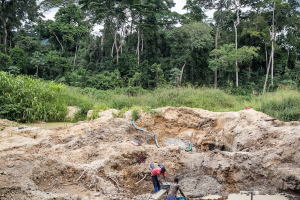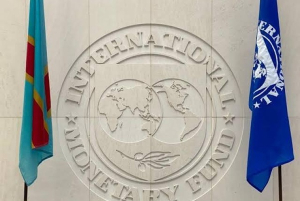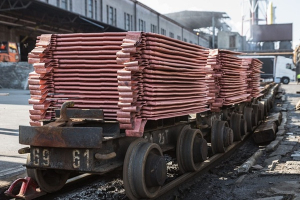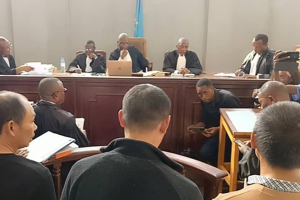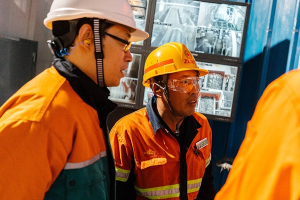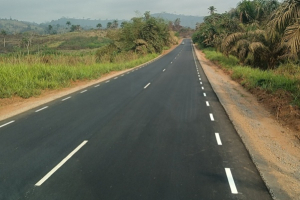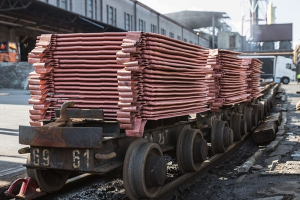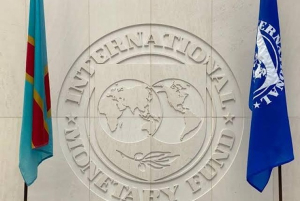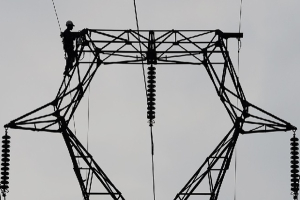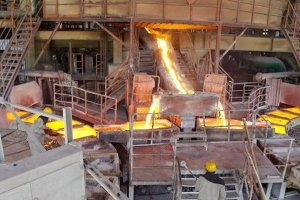Equipe Publication
Changement climatique : un rapport pointe l’impact des mines au Katanga
Un récent rapport de l’Observatoire africain des ressources naturelles (Afrewatch) révèle l’impact de l’exploitation minière sur la déforestation dans les provinces du Haut-Katanga et du Lualaba, en RDC. Entre 2001 et 2023, le Haut-Katanga a perdu 7120 km² de forêts, avec 498,4 km² attribués directement aux activités minières, tandis que le Lualaba a enregistré une perte totale de 5550 km², dont 388,5 km² liés au secteur minier. L’étude souligne que l’essor des activités minières après leur libéralisation en 2002 a amplifié cette déforestation.
Selon les données du rapport, les activités minières sont responsables de 7 % de la perte de couvert forestier enregistrée dans les provinces du Haut-Katanga et du Lualaba. Bien que ce chiffre soit relativement modeste comparé à d’autres facteurs, tels que l’agriculture et l’exploitation artisanale du bois, il n’en reste pas moins préoccupant en raison des conséquences climatiques et économiques qui en découlent.
Les destructions forestières entre 2001 et 2023 ont diminué la capacité des forêts à capturer le CO₂, entraînant des émissions supplémentaires estimées à 20 MtCO₂e pour le Haut-Katanga et 13,86 MtCO₂e pour le Lualaba. Le rapport souligne également que l’exploitation minière contribue à la fragmentation des forêts restantes, accélérant ainsi leur dégradation. De plus, l’extraction des minerais nécessite le déboisement de vastes zones, tant pour les sites d’exploitation que pour les infrastructures associées, comme les routes et les zones de stockage. Cette dynamique fragilise les écosystèmes forestiers et augmente l’exposition des populations aux risques climatiques.
Un impact social à ne pas sous-estimer
En plus de la perturbation des cycles naturels, qui affecte la pluviométrie et les températures, la déforestation entraîne des conséquences directes pour les communautés locales. Depuis 2005, les précipitations moyennes à Lubumbashi ont montré des variations importantes, avec des saisons des pluies plus courtes et des épisodes de sécheresse plus fréquents. De plus, la température moyenne a fluctué de manière inhabituelle, atteignant parfois des valeurs extrêmes.
Ces changements ont des répercussions sur les populations locales, notamment celles qui dépendent de l’agriculture. La réduction des précipitations et l’érosion des sols entraînent une baisse de la productivité agricole, mettant en danger la sécurité alimentaire et les revenus des ménages ruraux. Par ailleurs, la disparition des ressources forestières prive les communautés de produits essentiels comme le bois, les fruits ou certaines plantes médicinales.
Une prise en compte nécessaire des enjeux environnementaux
Les conclusions du rapport, bien que peu nouvelles, soulèvent la question du coût réel de l’exploitation minière en RDC. Elles interrogent sur la manière dont le pays peut concilier exploitation des ressources minérales et préservation de son environnement, surtout dans un contexte où la quête des minéraux critiques attire de nombreuses entreprises étrangères. Un rapport récent de la Banque mondiale évalue la valeur des réserves de minerais critiques de la RDC à 24 000 milliards de dollars, et le pays est reconnu parmi les plus riches en minéraux au monde. Pourtant, peu d’études abordent le prix que le pays et ses populations doivent payer pour concrétiser ce potentiel.
Bien que la RDC cherche à exploiter ses ressources minières pour soutenir son développement, il devient crucial de prendre en compte les impacts environnementaux. Sans des mesures adaptées, les bénéfices escomptés pourraient être partiellement annulés par les coûts croissants liés aux perturbations climatiques et aux pertes économiques qui en résultent.
LNK
Lire aussi :
Minerais critiques : les réserves de la RDC estimées à 24 000 milliards $
DR Congo: IMF Approves New Program Worth Around $3 Million
On January 15, 2025, the International Monetary Fund (IMF) Executive Board approved a new program with the Democratic Republic of Congo (DRC), following a service-level agreement reached in November.
The 38-month program has two main components: the Extended Credit Facility (ECF) worth $1.729 billion and the Resilience and Sustainability Facility (RSF) with $1.038 billion. Although these amounts are slightly lower than initially announced, the program’s goals have not changed: enhancing the country's macroeconomic stability, improving governance, and increasing resilience to climate challenges.
The ECF is designed to stabilize the economy, improve governance, and promote inclusive growth. Meanwhile, the RSF will support the DRC’s climate adaptation efforts, helping the country reduce its greenhouse gas emissions by 21% by 2030.
In 2024, the DRC achieved solid economic performance, with GDP growth projected at 6%, a significant drop in inflation, and reduced budget deficits, despite exceptional expenditures related to security and the fight against the Mpox epidemic.
The Central African nation also faced major climate-related disasters, including devastating floods that affected over 300,000 households, destroyed buildings, and killed 300 people. The crisis has exacerbated health risks and affected agricultural production. It called for urgent humanitarian responses and more funds to boost climate resilience.
According to IMF Deputy Managing Director, Kenji Okamura, while the DRC has shown resilience in the face of crises, sustained efforts are crucial to consolidate economic and social gains, combat corruption, and address climate challenges.
The previous IMF program concluded in 2021 helped strengthen foreign exchange reserves and boost growth, but structural and climatic challenges persist.
Under the ECF, the IMF champions reforms to help the DRC increase tax revenue, improve public financial management, and depend less on mining revenues. As for the RSF, it focuses on achieving climate objectives, such as forest preservation and sustainable natural resource management.
Despite risks from ongoing conflicts and health crises, the IMF’s outlook for 2025 remains positive, with growth forecast at 5.1% and inflation projected at 7%.
This article was initially published in French by Charlène N’dimon
Edited in English by Ola Schad Akinocho
Copper: DRC's Exports Nears 3 Million Tonnes Annually
The Democratic Republic of Congo (DRC) has exported 2.35 million tonnes of copper in the first nine months of 2024. The figure, featured in a report issued on 30 December 2024 by the Ministry of Mines, is up 17% year-on-year. Based on this performance, the report’s authors estimated that the country’s exports for 2024 could stand at 3 million tonnes, thus setting a new record–at the national and continental levels.
According to the Ecofin Agency, a pan-African economic media, since June 2023, the DRC has exported over 750,000 tonnes of copper, on average, quarterly. The Central African country exported more than 800,000 tonnes in Q3 2024, Ecofin reports.
While the Ministry of Mines only releases sales figures without specifying whether exports include volumes from previous years, data from the Central Bank of Congo indicates little difference between production and sales.
Still, the DRC will remain the world's second-largest copper producer in 2024, ahead of Peru which produced 2.47 million tonnes between January and November, down 1.1% year-on-year. Chile kept its crown, with over 5 million tonnes produced last year.
The increased copper output substantially impacts the local economy, as the mineral accounts for more than two-thirds of Congolese exports and a significant portion of mining revenues, estimated at $5 billion for the 2025 budget.
This article was initially published in French by Emiliano Tossou (Ecofin Agency)
Edited in English by Ola Schad Akinocho
Exploitation minière illégale : 7 ans de prison pour trois Chinois
Trois ressortissants chinois ont été condamnés, le 14 janvier 2025, à sept ans de prison ferme pour des infractions liées à l’exploitation minière illégale en République démocratique du Congo (RDC). Les prévenus ont été arrêtés dans la province minière du Sud-Kivu, en possession de dix lingots d’or et de 400 000 dollars en espèces.
Selon les médias locaux, le tribunal a retenu cinq des sept chefs d’accusation initialement portés contre eux. Parmi ces charges figurent le séjour irrégulier en RDC, l’achat illicite et la détention illégale de minerais, l’entrave à la transparence dans l’industrie minière, ainsi que le blanchiment de capitaux. Gale Mambuba, président du tribunal, a également annoncé que les condamnés devront payer solidairement une amende de 600 000 dollars et seront expulsés de la RDC à l’issue de leur peine.
Le tribunal a ordonné que les fonds saisis soient versés au Trésor public, tandis que l’or confisqué sera remis à la Banque centrale du Congo (BCC).
Charlène N’dimon, Agence Ecofin
Lire aussi :
Sud-Kivu : l’État continue sa traque contre les exploitants illicites de minerais
DR Congo: Government Concerned by China’s Dominant Presence in Mining Sector
China's dominant presence in the Democratic Republic of Congo’s mining industry poses a “risk” to the African economy. Marcellin Paluku, Deputy Cabinet Director at the Ministry of Mines, made the claim yesterday, January 14, in an interview with Reuters.
“Today, 80% of our mines are with a single partner (China). So it's a risk [...] You never know what might happen. That's why we're now trying to diversify our partnerships, to avoid depending on a single partner,” Paluku declared, on the sidelines of a mining conference in Riyadh.
Further commenting on the DRC’s partnership diversification efforts, Paluku said the Congolese government was eager to negotiate with potential new investors, such as Saudi Arabia, India, and the European Union. However, he did not indicate at what stage these talks were. Regardless, his words match those of Kizito Pakabomba, the DRC’s Mining Minister. In October 2024, Pakabomba said the country sought to “attract better investors, more investors, and diversified investors.” At the time, he had mentioned the United Arab Emirates as a potential partner.
China's influence in the DRC's mining sector is evident in its ownership of major cobalt mines, such as those held by China Molybdenum Company (CMOC), and its significant stake in the Kamoa-Kakula copper mine through Zijin Mining.
The DRC is the world's leading producer of cobalt and the second-largest producer of copper, making it a focal point for international competition due to the strategic importance of these minerals in the energy transition and advanced technologies. The country's mineral wealth extends beyond copper and cobalt. The Congolese soil hosts other key minerals like zinc, 3T ores, diamonds, gold, uranium, and germanium.
This article was initially published in French by Aurel Sèdjro Houenou (Ecofin Agency)
Edited in French by Ola Schad Akinocho
DR Congo: Sicomines Announces Launch of Phase II of RN12 Road Rehabilitation Project
The second phase of construction and rehabilitation work on Route Nationale 12 (RN12) in the Kongo Central province, Democratic Republic of Congo (DRC), has begun. Mining company Sino-Congolaise recently announced the launch. According to local media, the project, valued at $47 million, is carried out by Société d'infrastructures Sino-Congolaise (SISC).
"The only access road to Tshela territory via the RN1, it crosses Lukula and passes through Manterne, a settlement between Matadi and Boma. The same road links Tshela to Seke-Banza and reaches Mbanza Ngungu via Luozi," Sicomines posted on X. While specific details concerning the project are yet to be released, phase I and II, combined, span 120 km.
Sicomines often support road infrastructure development, in line with its mining permit obligations. These obligations, revised in 2024, require the construction of various infrastructures, including roads, schools, health centers, and projects related to energy, environment, water access, and agriculture.
The company has completed or initiated several projects, including stadiums and agricultural warehouses. However, details on project selection and progress are poorly documented.
According to the new contract between the Congolese government and Sicomines, roadworks worth $624 million were scheduled for 2024, with an annual commitment of approximately $324 million from 2025 to 2040. The government's priority investment program also includes $714 million for various road projects, though it is unclear if this amount is additional or part of the expected royalties from Sicomines.
Sicomines is owned 68% by a Chinese consortium (Crec, Sinohydro, Zhejiang Huayou) and 32% by the Congolese state through Gécamines.
This article was initially published in French by Georges Auréole Bamba
Edited in English by Ola Schad Akinocho
Cuivre : les exportations de la RDC sur le point d'atteindre 3 millions de tonnes par an
Selon un rapport du ministère des Mines publié le 30 décembre, la République Démocratique du Congo (RDC) a exporté 2,35 millions de tonnes de cuivre au cours des neuf premiers mois de 2024, soit une augmentation de 17 % par rapport à l'année précédente. Si cette tendance se confirme, la RDC devrait atteindre 3 millions de tonnes exportées d'ici la fin de l'année, un record pour le pays et l'Afrique.
Selon les calculs de l'Agence Ecofin, les exportations trimestrielles de cuivre de la RDC ont dépassé les 750 000 tonnes en moyenne depuis juin 2023, avec plus de 800 000 tonnes exportées au troisième trimestre 2024.
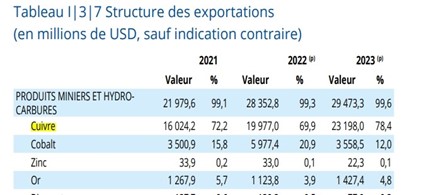
Le ministère congolais des Mines ne publie que les chiffres des ventes, sans préciser si certaines exportations proviennent de volumes produits les années précédentes. Les données de la Banque centrale du Congo montrent cependant peu de différences entre la production et les ventes. En tout cas, la RDC restera le deuxième producteur mondial de cuivre à la fin de 2024, après avoir dépassé le Pérou en 2023. La production du Pérou a atteint 2,47 millions de tonnes fin novembre 2024, en baisse de 1,1 % par rapport à l'année précédente, tandis que le Chili reste en tête avec plus de 5 millions de tonnes.
Au-delà des chiffres symboliques, la hausse de la production de cuivre en RDC renforce l'impact de ce métal sur l'économie locale. Selon la BCC, le cuivre représente plus de deux tiers des exportations congolaises et une part importante des recettes minières, estimées à 5 milliards $ pour le budget 2025.
Emiliano Tossou, Agence Ecofin
Lire aussi :
Cuivre : la production de la plus grande mine de RDC a atteint 437 061 tonnes en 2024
En RDC, 80 % des mines opérées avec des partenaires chinois (officiel)
Minerais critiques : les réserves de la RDC estimées à 24 000 milliards $
RDC-FMI : feu vert pour le nouveau programme de près de 3 milliards de dollars
Comme on pouvait s’y attendre, le Conseil d’administration du Fonds monétaire international (FMI) a approuvé, le 15 janvier 2025, le nouveau programme avec la République démocratique du Congo (RDC). Un accord avait en effet été conclu au niveau des services en novembre dernier. L’approbation du Conseil d’administration donne donc le feu vert pour la mise en œuvre du programme.
Comme déjà annoncé, ce programme de 38 mois s’articule autour de deux accords : la Facilité élargie de crédit (FEC), d’un montant de 1,729 milliard de dollars, et la Facilité pour la résilience et la durabilité (FRD), dotée d’une enveloppe de 1,038 milliard de dollars. Ces montants sont légèrement inférieurs à ceux annoncés lors de l’accord au niveau des services, mais les objectifs restent inchangés. Il s’agit de renforcer la stabilité macroéconomique du pays, d’améliorer sa gouvernance et d’accroître sa résilience face aux défis climatiques.
Concrètement, alors que la FEC vise à stabiliser l’économie, à améliorer la gouvernance et à encourager une croissance inclusive, la FRD soutiendra les efforts d’adaptation climatique pour positionner la RDC comme un acteur clé dans la transition vers une économie à faibles émissions de carbone, avec l’objectif de réduire ses émissions de gaz à effet de serre de 21 % d’ici 2030.
En 2024, la RDC a affiché une solide performance économique, avec une croissance du PIB projetée à 6 %, une baisse significative de l’inflation, qui est passée de 23,8 % fin 2023 à 12,8 % en novembre 2024, et une réduction des déficits budgétaires, malgré des dépenses exceptionnelles liées à la sécurité et à la lutte contre l’épidémie de Mpox.
Parallèlement, le pays a été confronté à des catastrophes climatiques majeures, notamment des inondations dévastatrices qui ont touché plus de 300 000 ménages, causé 300 décès et détruit des infrastructures essentielles. Ces événements ont exacerbé les risques sanitaires et affecté la production agricole, nécessitant des réponses humanitaires urgentes et des investissements pour renforcer la résilience climatique.
Selon M. Okamura, directeur général adjoint du FMI, la RDC a démontré sa résilience face aux crises, mais des efforts soutenus restent indispensables pour consolider les acquis économiques et sociaux, tout en intensifiant la lutte contre la corruption et les défis climatiques.
Les progrès réalisés dans le cadre du précédent programme conclu en 2021 ont permis au pays de renforcer ses réserves de change et de dynamiser la croissance. Cependant, des défis structurels et climatiques persistent.
Dans le cadre de la FEC, le FMI encourage des réformes visant à accroître la mobilisation des recettes fiscales, améliorer la gestion des finances publiques et réduire la dépendance aux fluctuations des revenus miniers. Concernant la FRD, l’accent sera mis sur la réalisation des objectifs climatiques du pays, notamment la préservation des forêts et la gestion durable des ressources naturelles.
Malgré les risques liés aux conflits persistants et aux crises sanitaires, les perspectives pour 2025 restent positives, avec une croissance prévue à 5,1 % et une inflation projetée à 7 %, selon les données de l’institution.
Charlène N’dimon
Lire aussi :
La RDC conclut un accord pour près de 3 milliards de dollars avec les services du FMI
Kamoa-Kakula: Ivanhoe Mines Could Start Importing Power from Angola by 2030
Ivanhoe Mines is considering importing hydropower from Angola to ensure optimal operations at the Kamoa-Kakula copper complex in the Democratic Republic of Congo (DRC). The Canadian company operates the complex and is one of its shareholders (39.6%), alongside Zijin Mining Group (39.6%), Crystal River (0.8%), and the Congolese state (20%).
Ivanhoe claims it could start importing the electricity by 2030, via a 2,000 MW high-voltage transmission line. The facility, yet to be built, would transport power from northern Angola to the Copperbelt in the DRC and Zambia.
The project is being developed by Trafigura and ProMarks, which signed a Memorandum of Understanding with the Angolan government in July 2024 to study the project's technical and economic viability. The developers plan to form a joint venture to develop, finance, build, and run the line.
"The project should be financed through a combination of equity and debt. Planning, approvals and construction would take approximately four years after the final investment decision," Ivanhoe Mines indicated.
According to the Canadian operator, the Kamoa-Kakula complex requires about 240 MW to operate at full capacity (phase I, II, III, and the smelter). However, it currently uses 90 MW of domestic and imported hydroelectricity and has 160 MW of backup capacity from diesel generators. Due to insufficient electricity, the company is considering postponing the launch of the complex’s new copper smelter by three months. The smelter was initially set to start operations in March 2025.
Ivanhoe Mines has been seeking to tackle the issue by increasing its supply capacity, focusing on green electricity, which is cheaper and less polluting. It is also looking for internal and external solutions.
For example, the company counts on the fifth turbine of the 178 MW Inga II hydropower station, which should be commissioned in the second quarter of this year. According to Ivanhoe, “Kamoa-Kakula should initially be allocated an additional 70 MW of hydroelectricity from the grid over this period, with a gradual increase to 178 MW as grid improvement initiatives are completed.”
In the medium term, Ivanhoe Mines plans to boost electricity imports from Angola, which has significant unused hydroelectric power capacity. The African Development Bank (AfDB) notes that Angola currently has 1.5 GW of clean, unused hydroelectric power, expected to reach 3.5 GW by 2027. Besides, Sun Africa is building a 700 MW solar farm in Angola, using funds provided by the Export-Import Bank of the United States (EximBank).
The US plans to partner with Angola's National Electricity Transmission Company to develop cross-border and local transmission lines, further integrating Angola into regional power pools. The lines should also supply power to the Lobito corridor
This article was initially published in French by Aboudi Ottou
Edited in English by Ola Schad Akinocho
DR Congo: Kamoa Copper Pre-Sells 80% of Its Copper Anodes Output to Two Firms
Kamoa Copper, the firm running the Kamoa-Kakula copper mine in the Democratic Republic of Congo (DRC), just pre-sold 80% of copper anodes from its new smelter set to launch this year. The pre-sale deals were inked with CITIC Metal Limited and Gold Mountains International Mining Company Limited. They have paid $500 million in advance, which the seller has already cashed in.
Both buyers are linked to Kamoa Copper’s shareholder Zijin Mining. In 2021, CITIC Metal and Gold Mountains entered a deal with Kamoa Copper to buy the copper from its first on-site concentrator.
According to Ivanhoe Mines, co-owner of the project, the deal, which spans three years, was concluded on “competitive and independent commercial terms”. At full capacity, Kamoa Copper’s new smelter should deliver up to 500,000 tonnes of 99.7% pure copper anodes annually.
Kamoa Copper said it is in advanced negotiations to sign a third pre-sale deal for the remaining 20% of the smelter’s output, with similar terms.
Congolese State Wants In
The Congolese government recently unveiled ambitions to be more involved in the selling of the country’s mining output. It holds 20% of Kamoa Copper.
Last December, Minister of Foreign Trade Jean-Lucien Bussa announced that the State would participate in selecting buyers. At the time, Bussa explained that Congolese authorities suspected that Kamoa Copper’s prices did not match “the market’s competitive rates”. The move aims to boost revenues from Congolese copper mining and ensure a fair valuation of the country's natural resources.
The government's desire to manage sales more effectively is part of a broader effort to maximize economic benefits from the mining sector, which is crucial for the DRC's revenue. The Kamoa-Kakula project is one of the world's largest copper deposits and is central to this strategy. If this new sales control policy is implemented, it could alter the commercial relationship between Kamoa Copper and its main buyers. However, it remains to be seen how this will align with existing commitments between the company and its partners.
“From now on, the State will participate in the buyer selection process. This will ensure optimal sales and selling at market prices,” Minister Bussa had said during a conference.
High Stakes
The government's ambition to manage sales more effectively is part of a broader effort to earn more mining revenues. The Kamoa-Kakula complex will significantly contribute to the government’s ambition, being one of the world’s largest copper deposits, added that copper is one of the country’s top sources of income. If implemented, the new sales control policy could alter the commercial relationship between Kamoa Copper and its main buyers. However, it remains to be seen how this will align with existing commitments between the company and its partners.
In the meantime, Kamoa Copper keeps seeking to become one of the world's largest copper producers. Earlier this month, project partners announced a copper production target of 520,000 to 580,000 tonnes for 2025, up from 437,061 in 2024.
This article was initially published in French by Louis-Nino Kansoun
Edited in English by Ola Schad Akinocho





